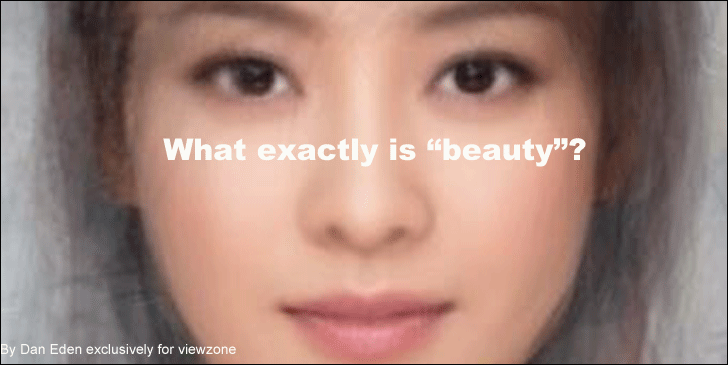
Beautiful People Do you remember being in high school or college and noticing a group of females who had their own exclusive group? More than likely they were the "popular" girls, the most pretty and conceited. When these pretty girls are depicted in movies they often get their egos crushed by less attractive classmates with better personalities. Unfortunately, in real life this is unlikely. Being "beautiful" has its rewards and these usually continue throughout adulthood. 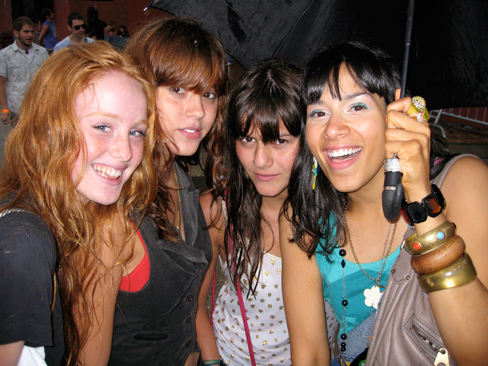 Studies show attractive people prefer to associate with others like themselves. The secret of beauty and attractiveness has been a quest of humans for as long as we have been civilized. Many women (and some "metrosexual" men) spend up to one-third of their income trying to look good. And contrary to what you might think, the reasons for this obsession with beauty go way beyond sexual attraction. Besides being popular, beautiful people get special attention from teachers, the legal system and especially potential employers [5]. Good-looking people tend to make more money than their plain-Jane counterparts. A study by the Federal Reserve Bank of St. Louis found that beautiful people tend to earn 5 percent more an hour than their less comely colleagues. If that weren't enough, the Fed also discovered a "plainness penalty", punishing below-average-looks with earnings of 9 percent less an hour [6]. Isn't beauty in the eye of the beholder? While we instinctively know what appeals to our own sense of beauty -- we know it when we see it -- defining what determines attractiveness is not always easy. In frustration, we often give up and claim that "beauty is in they eye of the beholder." But is beauty really a personal, subjective phenomenon? Recent studies have shown that the secret of beauty may at last be understood. It seems that attractiveness may be hard wired in our brains. Experiments designed to measure attractiveness usually involve showing a series of images of human faces and asking subjects to rate their visual appeal. Surprisingly, people from a variety of different ages, races and cultures agree on what is and isn't beautiful. Babies as young as 3 months can identify and prefer faces that most adults would deem beautiful. Europeans can pick out the same beautiful Japanese faces as Japanese subjects; Japanese can agree on which European faces another Europeans will view as beautiful. In fact, humans can even agree on the attractiveness of monkey faces [7], thus ruling out most unique racial, cultural and even species influences. So what's going on?
Our brains do much more than simply recognize a beautiful face. Most people can assess emotions, personality traits and fertility -- as well as beauty -- almost instantaneously. In fact, the human brain has special part called the fusiform, located in the back of the head, near the spine. It's the same neural pathway needed to recognize faces of family, friends and people we have met. When it's damaged, the patients cannot recognize anyone, even people they have just met. But especially interesting was the fact the patient with a damaged fusiform cannot discriminate between photographs of plain and beautiful faces! Good-looking Genes Studies show that when we recognize a face as "beautiful" we are actually making a judgement about the health and vitality of that individual. We interpret facial symmetry (the similarity of left and right halves of a face) and the smoothness of the skin to mean that a person has good genes and has been free from diseases. This is part of what we mean by "beautiful", but it is just the beginning. Scientists say that facial symmetry is one of the best observational indicators of good genes and healthy development and that these traits are what we mean when we say someone is attractive. Look at these examples below.
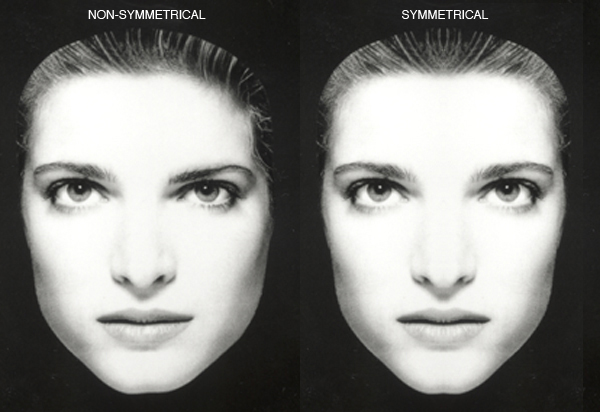 Which face do you think looks more healthy?
Facial Attraction: Choice Of Sexual Partners Shaped The Human Face Researchers at the Natural History Museum [9] have discovered that men with large jaws, flaring cheeks and large eyebrows are "sexy" -- at least in the eyes of our ancestors. Facial attractiveness played a major role in shaping human evolution. As studies on our fossil ancestors have shown, our choice of sexual partners has shaped the human face to what it is today.
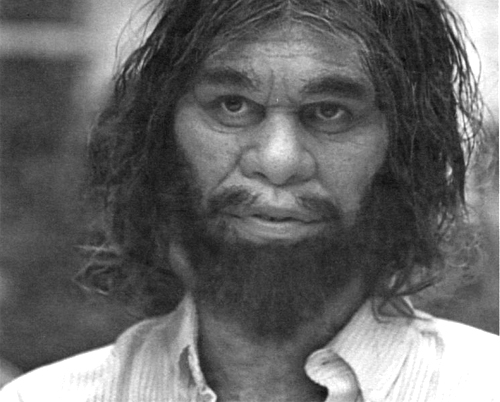 "I'm too sexy for my face..." Ancient fossils reveal how the human face went through an evolution to reach its present appearance. Throughout history, humans have been making judgements about desirable facial characteristics and mating more often with the opposite sex who had them. Eventually everyone had them. According to palaeontologists at the Natural History Museum, men have evolved short faces between the brow and upper lip, which exaggerates the size of their jaw, the flare of their cheeks and their eyebrows. The shorter and broader male face has also evolved along with shrunken canine teeth. This makes men look less threatening to competitors, yet attractive to mates.
In spite of their larger size, men have an upper face height similar to a female face, but much broader. These differences of height and width can be found throughout human history. They form a simple ratio, called the facial width-to-height ratio or WHR, which can be used to calculate facial attractiveness in a bio-mathematical way. In fact, scientists have recently invented a computer program that can recognize attractiveness by scanning a video camera or still photograph and calculating the width and height ratios of the subject's face [10].
"The evolution of facial appearance is central to understanding what makes men and women attractive to each other. We have found the distance between the lip and brow was probably immensely important to what made us attractive in the past, as it does now." -- Dr Eleanor Weston, palaeontologist at the Natural History Museum [11] Aggressive Personality Shows On Your Face According to a 2007 study [1], angry words and gestures are not the only way to get a sense of how temperamental a person is. According to the srudy published in Psychological Science, a quick glance at someone's facial structure is enough for us to predict their tendency towards aggression. Facial width-to-height ratio (WHR) is determined by measuring the distance between the right and left cheeks and the distance from the upper lip to the mid-brow. A high WHR means the width of the face is greater that the height -- in other words, a wide face. During childhood, boys and girls have similar facial structures, but during puberty, males develop a greater WHR than females. Research suggests that males with a larger WHR act more aggressively than those with a smaller WHR. A good example of this can be seen in the aggressive sport of hockey. Studies have shown that hockey players with greater WHR earn more penalty minutes for fighting and aggression per game than players with lower WHR.
In another experiment, psychologists Justin M. Carré, Cheryl M. McCormick, and Catherine J. Mondloch of Brock University wanted to see if it is possible to predict another person's propensity for aggressive behavior simply by looking at their photograph. In the study, participants were shown pairs of photographs or 'averaged' facial images of men and women in their early 20s with two opposing attitudes to relationships. The participants were asked to choose the face that they felt would be more open to short-term sexual relationships, one-night stands and the idea of sex without love. They were also asked which face they thought was the most attractive for a long- or short-term relationship, who was more masculine or feminine, and who they thought was generally attractive.
The photographs were very revealing. The Volunteer subjects estimates of how aggressive the photographed person was agreed with the results of the prior assessment. This was true even if they saw the picture for only 39 milliseconds. Apparently the brain can decide whether a person is aggressive almost instantly! Also interesting was the fact that the volunteer subjects estimated a higher aggression assessment to photographed faces with higher WHR ratios -- the greater the WHR, the higher the aggressive rating, reinforcing that we may use this aspect of facial structure to judge potential aggression in others. These findings indicate that subtle differences in face shape may affect personality judgments, which may, in turn, guide how we respond to certain individuals. And it all happens behind the scenes, unconsciously, in an instant. Many recent experiments have shown that, aside from symmetry, WHR ratios and being "healthy", men and women form opinions about attractiveness based on slightly different criteria which can change depending on such things as their age, hormones and potential for being a mate. Attractiveness From a Female's Perspective In one experiment [3], the researcher selected photographs of a man with what has been described as "feminine" features. These included a small nose, narrow chin and large eyes. This image was digitally morphed with an image of a very "masculine" face, with a strong jaw, big nose and small eyes. The two images were morphed in progressive steps in such a way that the viewer could adjust the degree of either masculine or feminine features with a slider, corresponding to which image the female subjects thought was most attractive. Subjects were also asked about their menstrual cycles to determine their potential fertility and estrogen levels.
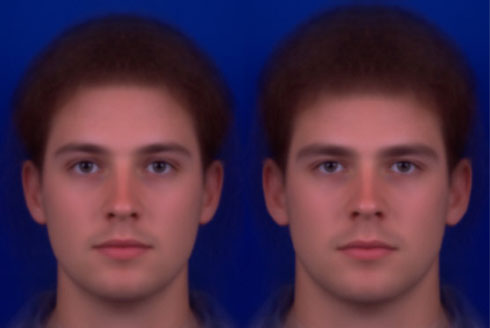 While most women preferred the middle range -- a combination of both feminine and masculine features -- subjects who were in their most fertile hormonal cycles preferred the more masculine image. The same women, when later tested during their infertile days, selected the more average looking male image as most attractive. Scientists reason that fertility causes hormonal changes in the brain that seek out strong testosterone traits in their potential mates. These traits are usually associated with aggressive behavior, risk taking and verility -- traits that are advantageous in the act of procreation. Some other interesting studies may be explained using this biological model. University of Aberdeen psychologist Ben Jones and his team tested the impact that the opinions of others has on our perception of beauty by giving women a test in which they had to choose the more attractive of pairs of male faces and to rate how much more handsome they found them. [15] They were then shown a short video in which the same faces were displayed. But each face was being looked at by a woman smiling or one showing a bored or neutral expression.
"We found that the slideshow caused women to become more attracted to the men who were being smiled at by other women." -- Aberdeen psychologist Ben Jones. This shows that people are using the attitudes of others to shape their own judgement about the attractiveness of some people. In other words, a woman may not be sure how attractive a face is. But if other women show that they're attracted they dismiss their doubt. This may explain the "groupie" and the "cult of personality" phenomenon and why so many ugly men learn to play the guitar. The test had the opposite effect on men. When they were asked to look at the same male faces, those who got the approving female glances were rated less attractive. Could this be jealosy? When women are assessing a man's face for a marriage partner they usually react to a man with a wide smile, small eyes, a big nose and a large jaw. This is thought to indicate a strong testosterone level, a potentially good provider and protector for family life. Studies show that younger women rely more on the physical attractiveness of a man than do older women. The latter incorporate such things as wealth, stability, power and faithfulness in their definition of attractive. This demonstrates wisdom since the most recent studies prove that less attractive men are more faithful and loving than handsome men. Attractiveness From A Male's Perspective
When reality sets in, less attractive people justify their less than beautiful partners by emphasizing their personality traits, like a sense of humor or kindness. The ideal face of an attractive woman, according to experiments with men, has high cheek bones, big eyes and a thin jaw. From infancy to adulthood, our faces are growing at different rates and proportions, depending on such things as hormones. When viewing the proportions of elements such as nose size and facial proportions, males usually select features that are characteristic of a woman of 24.8 years -- perhaps also related to the perceived age of optimal fertility. Some men prefer even younger proportions because these child-like faces stimulate emotions of caring and protection. These emotions seem to be more significant than sexual urges and procreation in some men. This can be in the psychological realm that dangerously approaches pathology and the law. Yet this "lolita" proclivity seems similarly hard wired [see viewzone article on pedophilia]. Professor Victor Johnstone, of the University of New Mexico studied this "lolita" phenomenon and reported that it was quite prevalent among all men:
The ideal body type
 [Above: Our changing concept of beauty... Venus of Willendorf (27,000 BCE),Boticelli's Primavera (1500s), Twiggy (1960s)] The ideal body type has changed throughout history, reflecting the changing roles of women and men alike. Primitive cultures viewed a woman as the mother of a family and preferred a healthy, corpulent figure. Small breasts and a wide pelvis triumphed during the Renaissance. By the 1970s, women were being viewed as separate from their sexuality. "Thin (no breasts) was in." So have things changed today?
Studies by Dr Devendra Singh published in the Royal Society Journal [12] show the optimal preferred waist to hip ratio was 0.67 to 0.80, while a larger waist was viewed by males as meaning the woman was more faithful and kind and a woman with a smaller waist was judged as being more aggressive and ambitious. Dr Michael Cunningham of Elmhurst College [13], Illinois, found that if a male is judging a female in an interview for a job, a woman with expressive eyebrows and dialated pupils has the edge and is likely to be considered more competent. The same features would not be judged as attractive if the same man was looking for a mate. Cunningham also found that attractive women with mature features, such as small eyes and a large nose, received more respect from men. "Average" is beautiful -- not! In the late 1870s, scientist and eugenicist Sir Francis Galton developed an image of the prototypical "face of crime" by creating composite photos of men convicted of serious offenses. Though Galton failed to discover anything abnormal in his composite criminal faces, he did find that the resulting visages were shockingly handsome. Later, Galton tried to make the case that a face with average proportions would always look more beautiful than a unique, individual face.
Scientists believed that average faces were more easy for the brain to recognize and require less analysis and processing in the fusiform. This ease of recognition was perceived as attractiveness. But this theory has recently been opposed by Dr David Perrett, of the University of St Andrews, who found that individual faces were judged more attractive than the composites.
"We found that not only were individual attractive faces preferred to the composites, but that when we used the computer to exaggerate the composite features away from the average,that too was preferred," he said. This would account for the popularity of actresses such as Brigitte Nielsen and Daryl Hannah [right], who have features that are far from average. Like Mother... Like Wife? Psychologist David Perrett [16] found that young men and women prefer faces that most resemble their mothers and fathers. Members of a close family also often share the interpretation of certain facial characteristics in judging someone's personality. Although this does not relate directly with beauty or attractiveness, it demonstrates that some aspects of evaluating facial characteristics may be learned. My own take on this is that it's a matter of nature and nurture. Various centers of our hard wired brain, like the fusiform, compete to control our daily decisions. One center is concerned with mate selection based on physical traits while other brain regions which have had social experience respond to a potential mate who is also intelligent, honest, faithful, kind and sane. Attractiveness, in the end, actually is unique to each individual. It encompasses instincts of survival which are tempered by social experiences and the need for certain qualities, like kindness, intelligence and compatibility. But scientists have also shown that we may be attracted to less permanent characteristics, like the willingness to have casual sex. And apparently we can sense that in a person's face also. That Look of Love Suitors can tell a young person's attitude to sexual relationships by the look on their face, according to new research [4] which gives deeper insight into mate attractiveness. The Durham University-led study of 700 heterosexual participants also found that young men and women look for completely opposite traits when it comes to relationships with the other sex. Men generally prefer women who they perceive are open to short-term sexual relationships while women are usually interested in men who appear to have potential to be long-term relationship material. Scientists say the research shows people can use their perceptions to make more informed partner selection depending on the type of relationship they are pursuing. The study is a significant step in further understanding the evolution of partner choice. Participants were asked to judge the attractiveness and attitudes to sex of the opposite sex from their facial photographs. These perceptual judgements were then compared with the actual attitudes and behaviours of the individuals in the photographs, which had been determined through a detailed questionnaire. The people in the photographs were all in their early 20s. The experiments found that the men and women taking part could generally judge from photographs who would be more interested in a short-term sexual relationship. In the first study sample of 153 participants, 72 per cent of people correctly identified the attitudes from photographs more than half of the time. However, further questioning showed that the participants were not always confident in their judgements.
The research, published in Evolution and Human Behavior [17], also found that women who were open to short-term sexual relationships were usually seen by others as more attractive -- although researchers can not determine precisely why without further investigation. The men who were most open to casual sex were generally perceived as being more masculine-looking, with facial features including squarer jaws, larger nose and smaller eyes. These findings support previous research carried out by the Durham team which found that women see masculine men as more likely to be unfaithful and as worse parents. Lead author Dr Lynda Boothroyd from Durham University's Psychology Department said: "Our results suggest that although some people can judge the sexual strategy of others simply from looking at their face, people are not always sure about their judgements possibly because the cues are very subtle. Yet preferences for different types of face were actually quite strong.
"This shows that these initial impressions may be part of how we assess potential mates -- or potential rivals -- when we first meet them. These will then give way over time to more in depth knowledge of that person, as you get to know them better, and may change with age". Professor David Perrett from the University of St Andrews cautioned: "While faces do hold cues to sexual attitudes, men should not presume any kind of relationship is wanted from appearance alone since women's choice is what matters. Indeed most women found promiscuous-looking guys unattractive for both short and long-term relationships".
Now what? Interpersonal attractiveness is just one of the many facets of what we call beauty. Its connection to sex, mating and procreation are obvious. So too is the fact that much of our appreciation of beauty appears hard-wired in our brains. But what about other kinds of beauty? We can all appreciate a beautiful scene or view, the beauty of a flower or a particular combination of colors or shapes. Are these also hard-wired? We'll explore some examples of beauty and explore how we can tell the good art from the bad. We'll ask the question: "If appreciation of art is hard-wired, what evolutionary significance does it imply?"

Notes:
[1] Weston EM, Friday AE, Lio P (2007) Biometric Evidence that Sexual Selection Has Shaped the Hominin Face. PLoS One 2(8): e710. doi:10.1371/journal.pone.0000710
[2] Rupp et al. Partner Status Influences Women's Interest in the Opposite Sex. Human Nature, 2009; 20 (1): 93 DOI: 10.1007/s12110-009-9056-6
[3] Steven W. Gangestad, Randy Thornhill, Christine E. Garver-Apgar. Men's facial masculinity predicts changes in their female partners' sexual interests across the ovulatory cycle, whereas men's intelligence does not. Evolution and Human Behavior, 2010; 31 (6): 412 DOI: 10.1016/j.evolhumbehav.2010.06.001
[4] Durham University (2008, April 9). Attitudes Towards Sexual Relationships Can Be Judged From Photos Of Your Face. ScienceDaily. Retrieved May 4, 2011, from http://www.sciencedaily.com /releases/2008/04/080408202048.htm
[5] Relative importance of applicant sex, attractiveness, and scholastic standing in evaluation of job applicant resumes.
Dipboye, Robert L.; Fromkin, Howard L.; Wiback, Kent
Journal of Applied Psychology, Vol 60(1), Feb 1975, 39-43. doi: 10.1037/h0076352
[6] http://money.cnn.com/2005/04/08/news/funny/beautiful_money/#TOP
[7] Leopold, D.A. & Bondar, I. (2005). Adaptation to complex visual patterns in humans and monkeys. )pp. 189-211), Oxford University Press; Leopold, D.A. & Bondar, I. & Giese, M.A. (2006) Norm-based face encoding by single neurons in the monkey inferotemporal cortex, Nature, 442, 572-575.
Dahl et al. The Thatcher illusion in humans and monkeys. Proceedings of The Royal Society B Biological Sciences, 2010; DOI: 10.1098/rspb.2010.0438
[8] Zaidel, D.; Aarde, S.; Baig, K. (2005). "Appearance of symmetry, beauty, and health in human faces". Brain and Cognition 57 (3): 261. doi:10.1016/j.bandc.2004.08.056. PMID 15780460.
[9] Weston EM, Friday AE, Lio P (2007) Biometric Evidence that Sexual Selection Has Shaped the Hominin Face. PLoS One 2(8): e710. doi:10.1371/journal.pone.0000710
[10] http://www.sciencedaily.com/releases/2008/04/080404122139.htm
[11] http://www.nhm.ac.uk/about-us/news/2007/august/news_12230.html
[12] Dr Devendra Singh, from the University of Texas, in a study published in a Royal Society Journal.
[13] Michael R Cunningham, Journal of Personality and Social Psychology (1986) Volume: 50, Issue: 5
[14] Carré J M, Morrissey M D, Mondloch C J, McCormick C M, 2010, "Estimating aggression from emotionally neutral faces: Which facial cues are diagnostic?" Perception 39(3) 356 – 377
[15] Little, AC., Saxton, TK., Roberts, SC., Jones, BC., DeBruine, L., Vukovic, J., Perrett, DI., Feinberg, DR. & Chenore, T. (2010). 'Women's preferences for masculinity in male faces are highest during reproductive age-range and lower around puberty and post-menopause'. Psychoneuroendocrinology, 35 (6), pp. 912-920.
[16] David Perrett, In Your Face: The New Science of Human Attraction (Palgrave Macmillan, 2010)
[17] Boothroyd, L.G., Jones, B.C., Burt, D.M., DeBruine, L.M., & Perrett, D.I. (2008) Facial correlates of sociosexuality. Evolution & Human Behavior, 29, 211-218
COMMENTS:
|

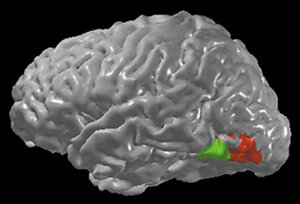 Facial recognition is a complex process. Only recently, with the need to spot criminals and terrorists, computer facial recognition programs have been developed to analyze the subtle variations of such things as the space between our eyes, the size of our noses and the proportions of our facial features. Scientists have discovered certain mathematical facial proportions that identify beautiful people. But there is more to beauty than the mere arrangement of eyes, noses and chins.
Facial recognition is a complex process. Only recently, with the need to spot criminals and terrorists, computer facial recognition programs have been developed to analyze the subtle variations of such things as the space between our eyes, the size of our noses and the proportions of our facial features. Scientists have discovered certain mathematical facial proportions that identify beautiful people. But there is more to beauty than the mere arrangement of eyes, noses and chins. 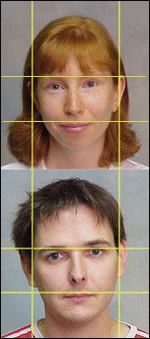 At puberty, the region between the mouth and eyebrows, known as upper facial height or UFH, develops differently in men and women. Unlike other facial features, this difference cannot be explained simply in terms of men being bigger than women.
At puberty, the region between the mouth and eyebrows, known as upper facial height or UFH, develops differently in men and women. Unlike other facial features, this difference cannot be explained simply in terms of men being bigger than women. 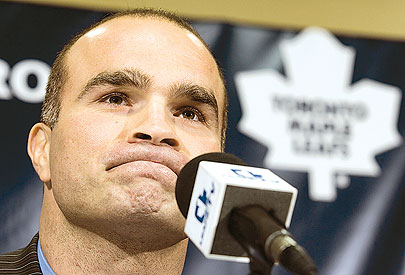
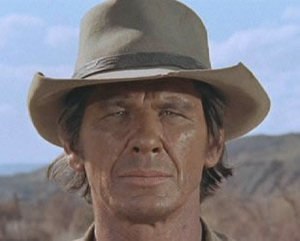 Volunteers viewed photographs of faces of men for whom aggressive behavior was previously assessed in the lab by calculating their WHR. The volunteers had no idea how the photographed subjects rated on the aggression scale. After viewing the photographs, the volunteer subjects rated how aggressive they thought each person was on a scale of one to seven. They were allowed to view the photographs of each face for either 2000 milliseconds or 39 milliseconds.
Volunteers viewed photographs of faces of men for whom aggressive behavior was previously assessed in the lab by calculating their WHR. The volunteers had no idea how the photographed subjects rated on the aggression scale. After viewing the photographs, the volunteer subjects rated how aggressive they thought each person was on a scale of one to seven. They were allowed to view the photographs of each face for either 2000 milliseconds or 39 milliseconds.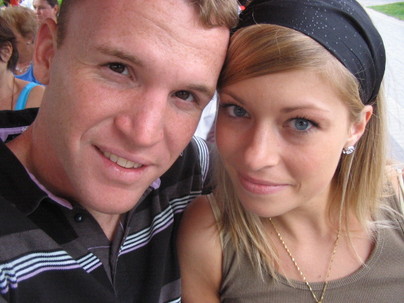 After watching the video, the researchers repeated the initial test.
After watching the video, the researchers repeated the initial test.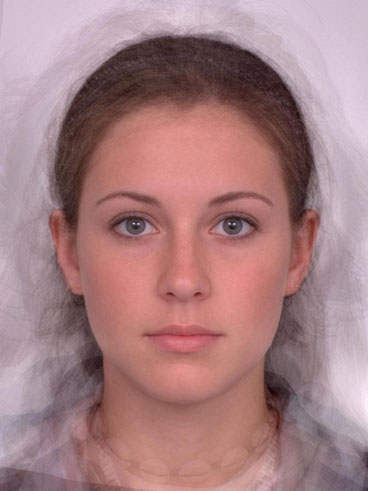 As might be expected, females tend to place less of their criteria for beauty on physical attractiveness than do males. This might be a lucky break for unattractive men! A recent study published in Psychological Science found that when seeking a date, men do not factor in their own attractiveness (or lack of) when assessing their chances of success with a beautiful woman. Sometimes they are lucky, but the study found that, most of the time, people with similar levels of physical attractiveness usually end up dating each other and they aspire to date people who are slightly more attractive than themselves.
As might be expected, females tend to place less of their criteria for beauty on physical attractiveness than do males. This might be a lucky break for unattractive men! A recent study published in Psychological Science found that when seeking a date, men do not factor in their own attractiveness (or lack of) when assessing their chances of success with a beautiful woman. Sometimes they are lucky, but the study found that, most of the time, people with similar levels of physical attractiveness usually end up dating each other and they aspire to date people who are slightly more attractive than themselves.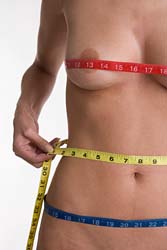 When it comes to body proportions, most men usually report liking big breasts and hips -- again possibly linked to the ability to bare and nurture offspring. Estrogen, the hormone associated with female fertility, encourages fat deposits around the buttocks and thighs. So full buttocks and a narrow waist send out the same message as the ideal face: "I'm full of estrogen and very fertile."
When it comes to body proportions, most men usually report liking big breasts and hips -- again possibly linked to the ability to bare and nurture offspring. Estrogen, the hormone associated with female fertility, encourages fat deposits around the buttocks and thighs. So full buttocks and a narrow waist send out the same message as the ideal face: "I'm full of estrogen and very fertile."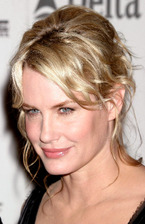 Subsequent studies of both men and women had shown that averaging features seemed to make the faces more attractive than any specific face. When a collection of computer averaged faces and real female faces were submitted to a famous modeling agency for comments, 80% of the computer generated faces were selected as having potential to be a model.
Subsequent studies of both men and women had shown that averaging features seemed to make the faces more attractive than any specific face. When a collection of computer averaged faces and real female faces were submitted to a famous modeling agency for comments, 80% of the computer generated faces were selected as having potential to be a model. 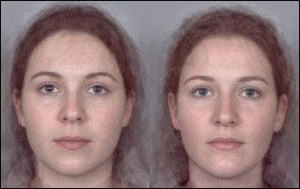 The composite image on the right is more likely to be interested in a short-term sexual relationship. (Credit: Image courtesy of Durham University)
The composite image on the right is more likely to be interested in a short-term sexual relationship. (Credit: Image courtesy of Durham University)